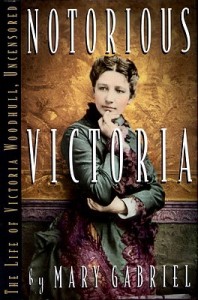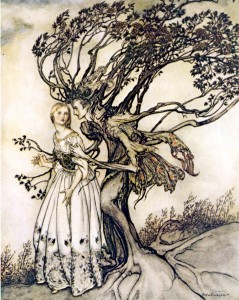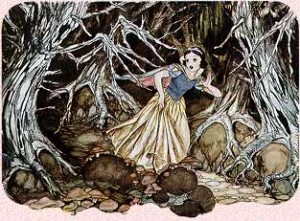 I heard the name of Victoria Woodhull in a specialized course, History of American Women, in college. My college years are considered pre-historic, and as such, you would have thought by now everyone would be not only aware of women who were movers and shakers in our past, but they’d be required study–or–like white males, just plain studied. No, of course not. 40 years more or less didn’t bring both sexes and various ethnic people into the discourse. History still belongs to those who write it and apparently those who write it are white males–or, and I have nothing to back this up except ignorance displayed by the younger among us, current history books and courses aren’t current in the sense of inclusion, but in edition number. When I was in grade and high school, the only women that had anything to do with our country’s beginnings consisted of one who mythically sewed a flag, and another who served water on the battlefield–oh, and one president’s wife saved some portraits when the White House burned. Betsy Ross’s house is nearby in Philly, and although the story is discredited time and again, the fantasy lives on. Molly Pitcher is immortalized in a touching way–one of the New Jersey Turnpike’s rest stops bears her name. And Dolly Madison churns out ice cream. That’s it, they are the sum total of women who existed with a contribution to our country’s emergence. And if you notice–their notoriety is contained within the domestic arena.
I heard the name of Victoria Woodhull in a specialized course, History of American Women, in college. My college years are considered pre-historic, and as such, you would have thought by now everyone would be not only aware of women who were movers and shakers in our past, but they’d be required study–or–like white males, just plain studied. No, of course not. 40 years more or less didn’t bring both sexes and various ethnic people into the discourse. History still belongs to those who write it and apparently those who write it are white males–or, and I have nothing to back this up except ignorance displayed by the younger among us, current history books and courses aren’t current in the sense of inclusion, but in edition number. When I was in grade and high school, the only women that had anything to do with our country’s beginnings consisted of one who mythically sewed a flag, and another who served water on the battlefield–oh, and one president’s wife saved some portraits when the White House burned. Betsy Ross’s house is nearby in Philly, and although the story is discredited time and again, the fantasy lives on. Molly Pitcher is immortalized in a touching way–one of the New Jersey Turnpike’s rest stops bears her name. And Dolly Madison churns out ice cream. That’s it, they are the sum total of women who existed with a contribution to our country’s emergence. And if you notice–their notoriety is contained within the domestic arena.
Day: November 23, 2012
Arthur Rackham

When I first discovered golden age children’s illustration, Arthur Rackham reigned supreme. I was enamored with his fairies, elves, sprites in various forms–from Peter Pan, to English Fairy Tales, to Rip Van Winkle and The Wonder Book. Not able to afford first editions, even then, I settled for typical reprints. Not exactly the finest copies, at least they made more of his illustrations available to me than did the David Larkin outsize paperbacks showcasing the various artists. After a trip to London and a bunch of postcards later, I was so transfixed by his art, I decided to write a thesis for a theatre class in college. The thesis had three

parts. The first, a written analysis of his work and influence, second, makeup based up his characters, and third, a small production utilizing aspects from his artwork. I can’t for the life of me remember what the makeup consisted of, nor what the small production was all about–but I still have my paper–with grammatical errors, misspellings, and postcard examples of his work, still intact.
